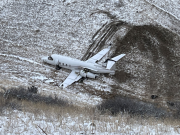A disproportionate number of runway side excursions — veer-offs — that occur in reduced visibility also occur on wider-than-usual runways, especially those without centerline lighting, the Australian Transportation Safety Bureau (ATSB) says.
The ATSB said, in a report released Wednesday about a Dec. 16, 2016, veer-off involving a Boeing 737 at Darwin Airport, that it reviewed 15 similar runway excursions in Australia, Canada and elsewhere and found that all 15 occurred at night, in reduced visibility and on runways without centerline lights.
Eleven of the 15 veer-offs occurred on runways wider than 50 m (164 ft), and 13 occurred during a Category 1 instrument landing system approach, the report said. The other two occurred during non-precision approaches on runways narrower than 50 m. In addition, 13 veer-offs involved high-capacity air transport aircraft — those with more than 38 seats.
As a result of its review, the ATSB recommended that the International Civil Aviation Organization (ICAO) review its runway lighting standards.
In its report on the Darwin accident, the ATSB said that accident investigators determined that the Virgin Australia 737-800 had touched down more than 20 m (66 ft) to the right of the runway centerline and continued toward the side of the runway. The right main landing gear ran off the runway edge for 400 m (1,312 ft), destroying six runway lights before being returned to the runway. No one was injured, and the 737 received minor damage.
The investigators found that the crosswind had increased slightly “at a critical time a few seconds before touchdown, and the crew were not aware how far the aircraft had deviated,” the report said.
“The two rows of lights alongside Runway 29 at Darwin are further apart than what a flight crew would normally encounter, due to the relatively wide runway. The ATSB found that, in the absence of centreline lighting, this characteristic affected the crew’s ability to detect and correct the aircraft’s deviation.”
After the investigation, Virgin Australia and Darwin Airport both implemented several safety actions, including providing flight crews with more information about the specific risks of a nighttime approach to Darwin in reduced visibility, the report said.
The report noted that the ATSB had recommended the installation of centerline lights at Darwin after a veer-off in 2003. Both the Australian Department of Defence and Darwin International Airport, which jointly own the airport, have said they will consider the recommendation during future work on the runway.



